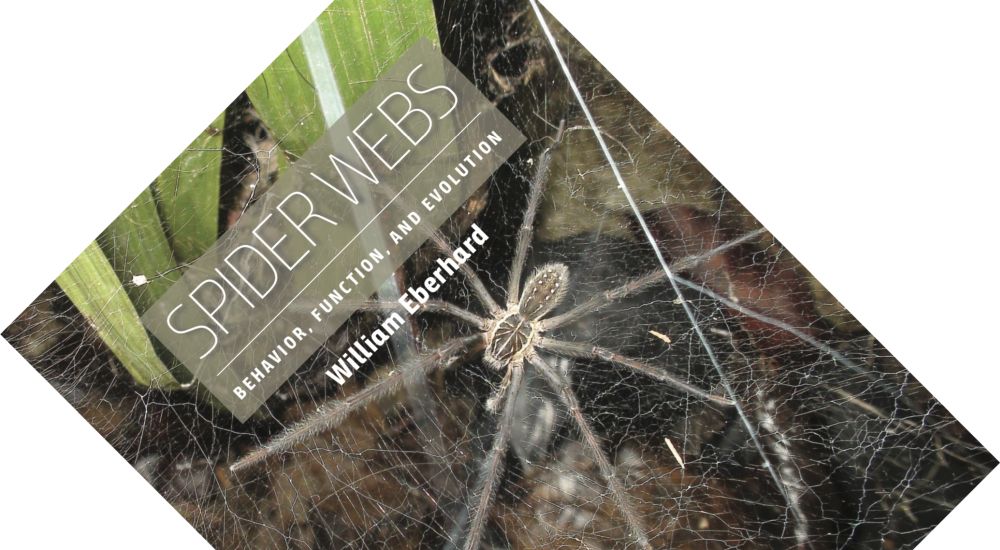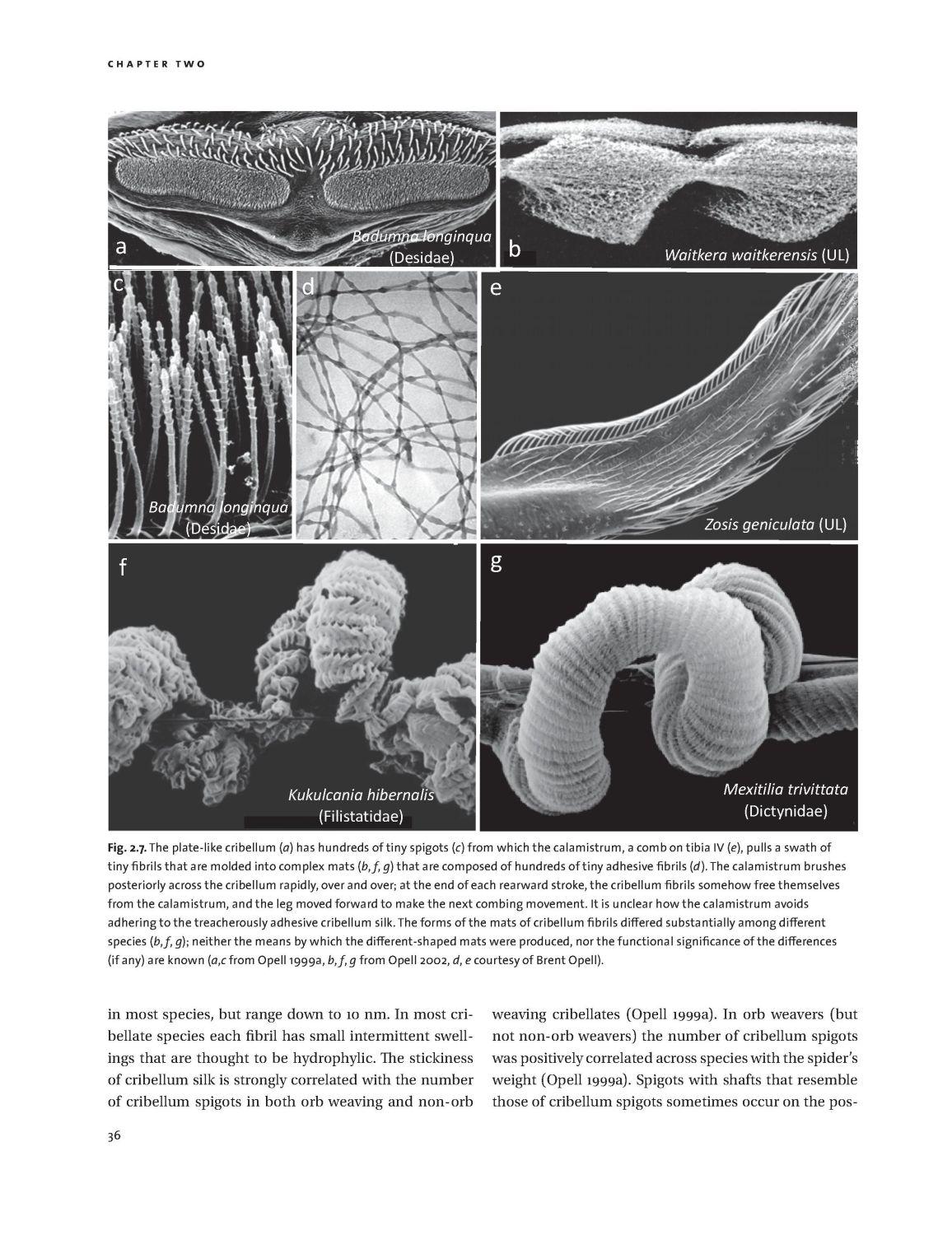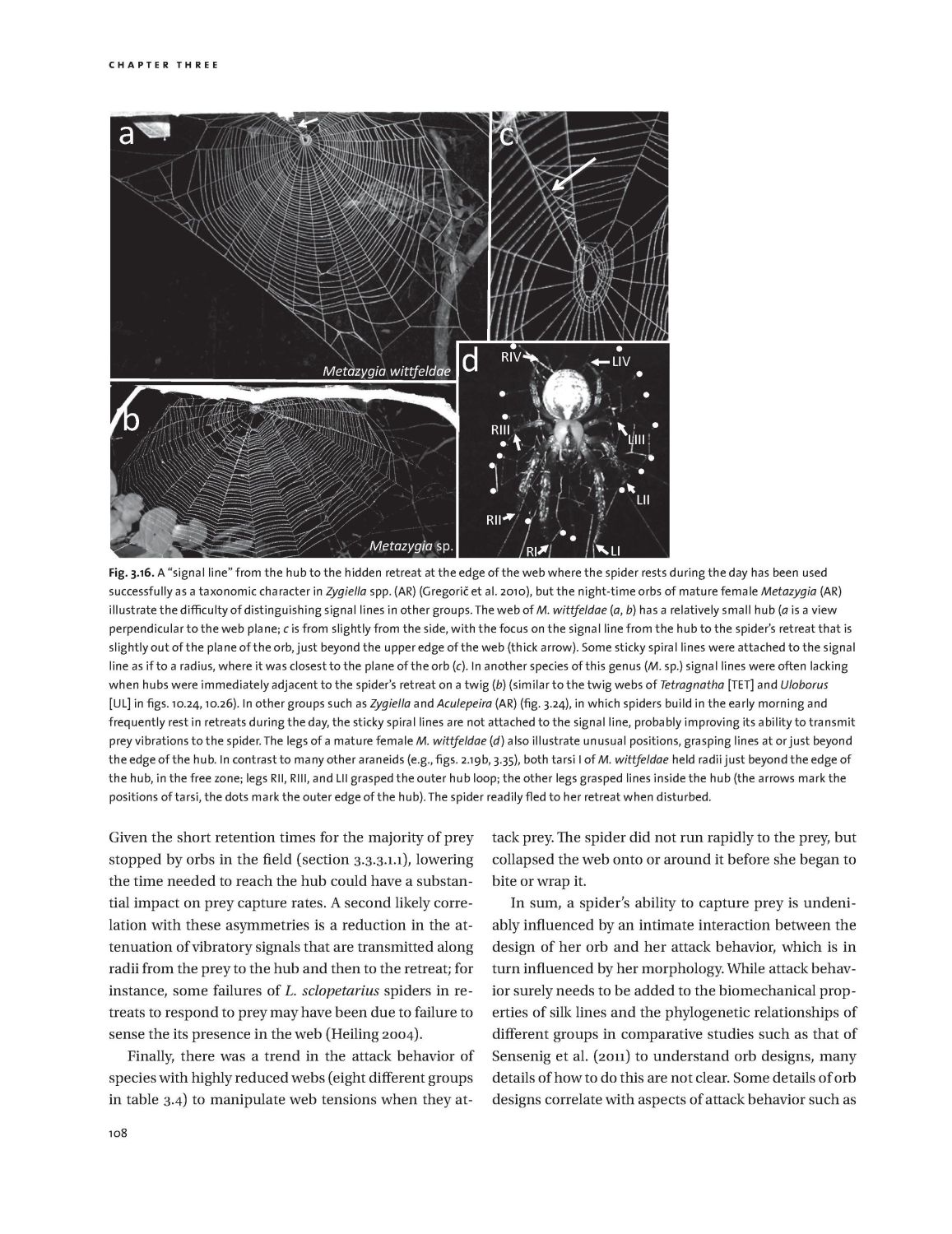8-minute read
You would think that after centuries of studying spider webs we have a pretty good grasp of them. Yet a thorough, book-length review of their construction, function, and evolution has been missing. Emeritus Professor William Eberhard has taken on that colossal task, based on his nearly 50 years of observing spiders and their webs. Some works go on to define their discipline. Spider Webs has all the trappings of becoming the arachnological benchmark for many years to come.

Spider Webs: Behavior, Function, and Evolution, written by William G Eberhard, published by the University of Chicago Press in August 2020 (hardback, 658 pages)
Spider Webs is big. Really big. This arachno-tome intimidates as much as it edifies. Some stats: A 21 × 28 cm, 658-page hardback containing ten chapters sprawling over 581 pages, 39 pages of references, and a 36-page index. A 12-page table of contents revealing the book’s highly nested structure, many sections going down 4–6 levels (you may find yourself reading section 3.3.4.2.2.5 on the importance of UV reflectance of silk stabilimenta). Almost 300 black-and-white photos and drawings of webs, often of species not included in previous literature. And if that was not enough, a 91-page online supplement with small print containing additional observations, tables, and musings. What makes these numbers mildly terrifying is that Eberhard almost apologetically mentions he avoids so much detail as to overwhelm the reader, and that “a truly thorough summary of our current knowledge would be crushingly dull” (p. 10). Yes, 750 pages is what Eberhard holding back on his encyclopedic knowledge looks like.
 So, what is in the book? Eberhard includes much older literature often skipped over in review papers, and has included numerous of his own unpublished observations. He starts with a chapter on the spider’s hardware (silk glands, spinnerets, and legs) and ends with two chapters on evolution. The construction and function of webs in chapters 3–8 forms the core of the book, though the order in which topics are discussed is not necessarily how a spider proceeds. Thus, Eberhard begins with an extended chapter on the function of orb webs, including 45 pages discussing incorrect and unsupported ideas, followed by a chapter on the many trade-offs between different properties and parts of a web, e.g. tensions on lines or the number and spacing of radii and spirals of sticky silk. Having discussed function, Eberhard then turns to how webs are constructed and what cues spiders use. For non-orb weavers our knowledge is so fragmented that a short chapter summarises “scattered bits and pieces of information” (p. 273). Orb weavers have been much better studied, and the descriptions of building behaviour (how a spider moves its legs and body to make an orb web) and the cues used to decide where to lay and attach lines span 120 pages in two chapters. And thus the first step in the process, how a spider decides where and whether to build a web, is discussed last. The properties of spider silk are only discussed briefly, and I refer readers wanting more details to two books by Catherine Craig.
So, what is in the book? Eberhard includes much older literature often skipped over in review papers, and has included numerous of his own unpublished observations. He starts with a chapter on the spider’s hardware (silk glands, spinnerets, and legs) and ends with two chapters on evolution. The construction and function of webs in chapters 3–8 forms the core of the book, though the order in which topics are discussed is not necessarily how a spider proceeds. Thus, Eberhard begins with an extended chapter on the function of orb webs, including 45 pages discussing incorrect and unsupported ideas, followed by a chapter on the many trade-offs between different properties and parts of a web, e.g. tensions on lines or the number and spacing of radii and spirals of sticky silk. Having discussed function, Eberhard then turns to how webs are constructed and what cues spiders use. For non-orb weavers our knowledge is so fragmented that a short chapter summarises “scattered bits and pieces of information” (p. 273). Orb weavers have been much better studied, and the descriptions of building behaviour (how a spider moves its legs and body to make an orb web) and the cues used to decide where to lay and attach lines span 120 pages in two chapters. And thus the first step in the process, how a spider decides where and whether to build a web, is discussed last. The properties of spider silk are only discussed briefly, and I refer readers wanting more details to two books by Catherine Craig.
“[…] published descriptions of webs and spider behaviour make it appear as if there are only a few ways of doing things, but that is a limitation of our language, not a reflection of reality.”
Spider Webs is not a particularly difficult book. Eberhard wanted it to be accessible to the general reader and has by and large succeeded, I think. Any reader serious about tackling a book this size is probably already familiar with the terminology and conventions used here. If not, no harm can become the spider novice from first reading e.g. Biology of Spiders. Spider Webs is, however, particularly rich in detail and minutiae. This is where the highly nested chapter structure comes into its own. I found it useful to bookmark the contents and refer to them while reading to keep my bearings. Throughout, there are summaries in subsections and summaries at the end of chapters, and summaries of summaries. The take-home messages are spelt out clearly, and I will highlight a few prominent ones.
 Eberhard warns against typology: published descriptions of webs and spider behaviour make it appear as if there are only a few ways of doing things, but that is a limitation of our language, not a reflection of reality. “The” web does not exist: there is much variation on the level of families, genera, species, and even individuals in the details of web construction, much of it poorly documented. There are fascinating variations on the theme (the elongated ladder webs to catch moths are but one of many examples included here). And this is before you even consider the material here on non-orb weavers. Tying in with that, the idea that spiders are little web-spinning automatons is mistaken. True, freshly hatched spiderlings succeed at their first attempt, and there is little indication that spiders improve with practice, but they combine information from a wide variety of cues (environmental and otherwise) during web construction and can modify their behaviour as needed. Eberhard discusses 10–16 cues, depending on how you count and which ones you consider independent of each other.
Eberhard warns against typology: published descriptions of webs and spider behaviour make it appear as if there are only a few ways of doing things, but that is a limitation of our language, not a reflection of reality. “The” web does not exist: there is much variation on the level of families, genera, species, and even individuals in the details of web construction, much of it poorly documented. There are fascinating variations on the theme (the elongated ladder webs to catch moths are but one of many examples included here). And this is before you even consider the material here on non-orb weavers. Tying in with that, the idea that spiders are little web-spinning automatons is mistaken. True, freshly hatched spiderlings succeed at their first attempt, and there is little indication that spiders improve with practice, but they combine information from a wide variety of cues (environmental and otherwise) during web construction and can modify their behaviour as needed. Eberhard discusses 10–16 cues, depending on how you count and which ones you consider independent of each other.
“A particular sticking point is ecological realism. Much data that is collected […] is flawed or of questionable relevance to spiders.”
Orb webs are not optimum structures: “[…] there is a veritable minefield of variables that can affect the chances that a web will capture prey” (p. 78). Despite claims to the contrary, demonstrating optimality is very hard and, Eberhard believes, has never been done empirically. Nor are orb webs the pinnacle of evolution. Despite the higher-level phylogeny of spiders not being fully resolved, there is little doubt that orbs have evolved and secondarily been lost again multiple times. The large-scale evolutionary pattern is one of both high diversity and frequent convergence, resulting from “an especially ancient and thorough exploration of the adaptive space associated with webs” (p. 479). In other words, given hundreds of millions of years of evolution, is there anything spiders have not tried? (Actually, yes, as shown here by some interesting comparisons with other silk-producing insects.)
 Next to everything we know, Spider Webs is as much a book about what we do not know. Eberhard reviews the many suggested functions of web traits, only to point out that, bar preliminary results or casual observations, we often lack empirical data to decide one way or another. He concludes an extended discussion on the possible functions of silk stabilimenta with the admission that it sounds like a “litany of frustration” (p. 180). I had not heard of them before, but they will have even seasoned arachnologists pull out their hair. A particular sticking point is ecological realism. Much data that is collected (on e.g. number of prey available in the environment or their nutritional value) is flawed or of questionable relevance to spiders: “the cues that are used by spiders are not necessarily the same as the variables that are commonly measured by researchers” (p. 435). And we must not forget that spiders evolved in habitats undisturbed by humans until recently. Most data is now gathered in environments that spiders did not evolve in. He admits this might seem like: “nihilistic surrenders to hopeless ignorance” (p. 87).
Next to everything we know, Spider Webs is as much a book about what we do not know. Eberhard reviews the many suggested functions of web traits, only to point out that, bar preliminary results or casual observations, we often lack empirical data to decide one way or another. He concludes an extended discussion on the possible functions of silk stabilimenta with the admission that it sounds like a “litany of frustration” (p. 180). I had not heard of them before, but they will have even seasoned arachnologists pull out their hair. A particular sticking point is ecological realism. Much data that is collected (on e.g. number of prey available in the environment or their nutritional value) is flawed or of questionable relevance to spiders: “the cues that are used by spiders are not necessarily the same as the variables that are commonly measured by researchers” (p. 435). And we must not forget that spiders evolved in habitats undisturbed by humans until recently. Most data is now gathered in environments that spiders did not evolve in. He admits this might seem like: “nihilistic surrenders to hopeless ignorance” (p. 87).
“Spider Webs is one of those rare books that sets a discipline’s research agenda for decades to come and cannot be ignored.”
Eberhard berates fellow arachnologists throughout, e.g. for not documenting variation in construction behaviour and design within species, or the lax use of the word “sheet” when describing webs. But he is equally critical of his own failures and owes up to his changes of mind. For instance, his enthusiasm for using models to determine the advantages of different web designs has vanished, and he is no longer the proponent he was of using artificial webs to estimate prey availability. Table 9.4 lists beautiful ideas slain by ugly facts and “gives a sampler of disappointments (with my own failures perhaps over-emphasized)” p. 480. As a bonus, there is a 15-page table in the supplement with hundreds of unanswered questions for future students and researchers to pursue. One might think Eberhard a curmudgeon, but that would ignore the fact that nature is complex and does not readily yield to the order that we wish to impose upon it. Here is someone who has studied spiders intensely and I must agree with his outlook that “intellectual rigor is useful; little is gained (and much is lost) by ignoring the limitations of data to support or discard particular conclusions” (p. 87).
Spider Webs is one of those rare books that sets a discipline’s research agenda for decades to come and cannot be ignored. This book has set the bar and has set it high. For professional arachnologists this is a vital and invaluable reference work. For serious spider enthusiasts it is an absolute treasure trove. Beyond the spider community, however, there is much here of interest to ethologists and evolutionary biologists. Readers interested in more spider talk might also want to check out my Q&A with Eberhard published over at the NHBS Conservation Hub.
Disclosure: The publisher provided a review copy of this book. The opinion expressed here is my own, however.
Other recommended books mentioned in this review:
__________________________________________________________________






Please , I would read to this.
LikeLike